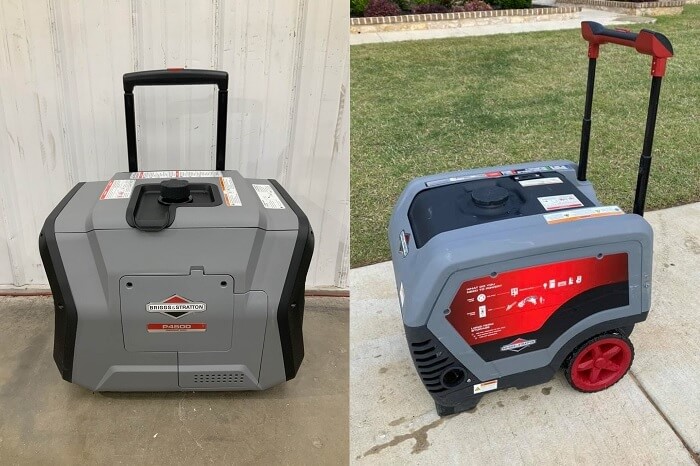Briggs & Stratton P4500 and Q6500: Which portable generator is the better option for you? Still, have no idea? Let’s scroll down to find the answer!
Differences Between Briggs & Stratton P4500 and Q6500
Below is a summary of the specifications


Power Comparison
Gasoline is fuel for both Briggs & Stratton P4500 and Q6500. However, their engines and power are very different from each other.
The P4500 model is equipped with a 224 cc Briggs & Stratton OHV 4-stroke engine. It could start running at 4500W and then continue at 3700W.
On the other hand, the Q6500’s 306 cc Briggs & Stratton OHV 4-stroke engine is much stronger. At normal capacity, it provides power at 5000W and could go up to a maximum of 6500W.
How long could your generator run? It is an important point to consider if you need a long-lasting engine. A full fuel tank could run P4500 in sixteen hours and Q6500 in fourteen hours.
Both P4500 and Q6500’s Total Harmonic Distortion (THD) are lower than 3%. Thus, it is safe to use them for your sensitive electronic devices.
When it comes to Fuel Consumption Gallon Per Hour (GPH), Briggs & Stratton P4500 is more efficient with 0.22 GPH. The Q6500 has a GPH of 0.36 GPH, which is not bad for an inverter generator.
The noise is an essential factor to consider as a generator. Briggs & Stratton Q6500 has a noise level of 66 dBA. Nevertheless, the P4500 is quieter with a noise level of 60 dBA.

Design Comparison
The P4500’s sizes are 24,5 x 17,6 x 20,36 inches, and it weighs 115 pounds. In the meantime, the GP3000i generator is similar in size but heavier. It is 24,8 x 21,2 x 21,5 inches in size and weighs 139 pounds.
Both generators include wheels and built-in handles. You can pull your machine around instead of carrying and holding them for a long time.

Features Comparison
There are two ways to turn on the Briggs & Stratton P4500, which are electric start and recoil start. On the other side, you only could turn on the Q6500 by pulling its recoil.
In terms of outlets, Briggs & Stratton P4500 and Q6500 could satisfy multiple types of outlets. They provide you with four 120V-20A outlets, two USB outlets, and one 120V-30A outlet.
On both machines, you will see a control panel. The Q6500’s panel notifies you about engine information such as power usage, fuel level, and run time.
Briggs & Stratton updates the Q4500 panel with an LCD for better information display. Moreover, connecting the two generators to Bluetooth is also a way to monitor power usage, fuel level, and run time.
Quick Rundown Of Briggs & Stratton P4500
No products found.
[i2pc show_title=”false” title=”Pros & Cons” show_button=”false” pros_title=”Pros” cons_title=”Cons” ][i2pros]Easy to pull with wheelsSimple with electric start
Long-running time
Affordable [/i2pros][i2cons]Noisy while running[/i2cons][/i2pc]

Quick Rundown Of Briggs & Stratton Q6500
- QuietPower Series Inverter Technology - Inverter technology produces power that’s more than 60% quieter than standard generators while delivering consistent power for essential home appliances, including sensitive electronics.
- 306cc Integrated Engine/Alternator - A highly-efficient integrated engine/alternator provides up to 14 hours of run time.
- Protective, Noise-Reducing Shell - With an all-steel frame enclosed in a protective shell, noise is minimized and internal components are protected.
- Compact, Lightweight Design - With a design that’s 45% more compact and 30% lighter than standard generators, moving and storing your generator is no hassle.
- CO Guard carbon monoxide shutdown technology - Shuts down the generator when harmful levels of carbon monoxide are detected
Powerful engine
Easy to pull with wheels[/i2pros][i2cons]Heavy and difficult to carry in a long time
Coil start only[/i2cons][/i2pc]

Product Videos
Conclusion
“Briggs & Stratton p4500 vs q6500”- You may now decide which is the best Briggs & Stratton generator for you. The Q6500 is more powerful in the case of multi-devices. If you want a light and long-lasting generator, the P4500 model is a great choice. See you in the next post!


